Church leaders point to inhospitable political atmosphere as they lock compounds at night; government ministries insist they are actively combating ill-treatment.
“If you are a Christian in the Middle East, there’s only one place where you are safe,” asserted Prime Minister Benjamin Netanyahu, speaking to Christian Zionists in Rio de Janeiro in December 2018. “There’s only one place where the Christian community is growing, thriving, prospering. That’s in the State of Israel.”
Netanyahu’s claim is a central element of the image Israeli officials put forward about the country when speaking to Western audiences.
Ahead of Christmas last year, Israel’s official Twitter account posted a video of the Foreign Ministry’s Digital Diplomacy chief David Saranga on a “magical Christmas stroll” through Jerusalem’s Old City.
The picture of safe coexistence painted by Israeli officials is starkly at odds with the experiences Jerusalem’s Christian leaders themselves describe. While they readily acknowledge that there is no organized or governmental effort against them, Christian clergy in the Old City tell of a deteriorating atmosphere of harassment, apathy from authorities, and a growing fear that incidents of spitting and vandalism could turn into something far darker.
And with Netanyahu already under scrutiny from Western allies over policies toward the Palestinians and attempts at sweeping judicial reform, deteriorating safety for Christians — or at least Church leaders disseminating that narrative — could become another serious diplomatic problem for Israel’s embattled government.
March of the schoolchildren
On Friday, hundreds of Catholic schoolchildren in Jerusalem embarked on their traditional march along the Via Dolorosa as they do every year during the 40 days of Lent.
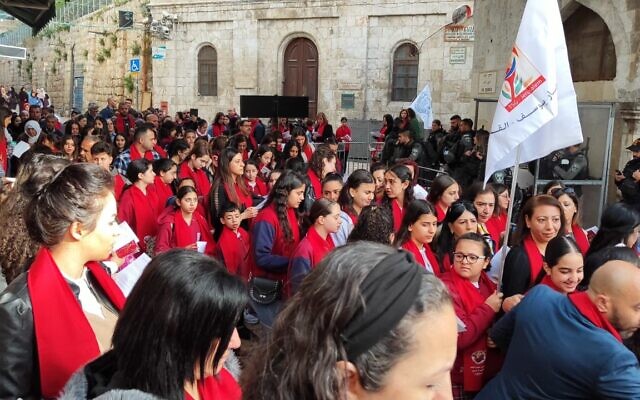
Catholic schoolchildren walk down the Via Dolorosa, March 24, 2023 (Filippo De Grazia)
This time was different, however.
The students set off from the Church of the Flagellation, the second station of the cross, all clad in identical red scarves that bore the image of a broken statue of Jesus, the Scourged Savior effigy vandalized by an American Jewish tourist in the church in February.
“If you are a Christian in the Middle East, there’s only one place where you are safe,” asserted Prime Minister Benjamin Netanyahu, speaking to Christian Zionists in Rio de Janeiro in December 2018. “There’s only one place where the Christian community is growing, thriving, prospering. That’s in the State of Israel.”
Netanyahu’s claim is a central element of the image Israeli officials put forward about the country when speaking to Western audiences.
Ahead of Christmas last year, Israel’s official Twitter account posted a video of the Foreign Ministry’s Digital Diplomacy chief David Saranga on a “magical Christmas stroll” through Jerusalem’s Old City.
State of Jerusalem: The ‘Secular’ StrugglePauseUnmute
Loaded: 19.36%Picture-in-PictureFullscreenClose
The picture of safe coexistence painted by Israeli officials is starkly at odds with the experiences Jerusalem’s Christian leaders themselves describe. While they readily acknowledge that there is no organized or governmental effort against them, Christian clergy in the Old City tell of a deteriorating atmosphere of harassment, apathy from authorities, and a growing fear that incidents of spitting and vandalism could turn into something far darker.
And with Netanyahu already under scrutiny from Western allies over policies toward the Palestinians and attempts at sweeping judicial reform, deteriorating safety for Christians — or at least Church leaders disseminating that narrative — could become another serious diplomatic problem for Israel’s embattled government.
Get The Times of Israel’s Daily Editionby email and never miss our top storiesNewsletter email addressGET IT
By signing up, you agree to the terms
March of the schoolchildren
On Friday, hundreds of Catholic schoolchildren in Jerusalem embarked on their traditional march along the Via Dolorosa as they do every year during the 40 days of Lent.

Catholic schoolchildren walk down the Via Dolorosa, March 24, 2023 (Filippo De Grazia)
This time was different, however.
The students set off from the Church of the Flagellation, the second station of the cross, all clad in identical red scarves that bore the image of a broken statue of Jesus, the Scourged Savior effigy vandalized by an American Jewish tourist in the church in February.
ADVERTISEMENT
The march, joined by the two senior Catholic figures in the Holy Land — Patriarch Pierbattista Pizzaballa and Custodian of the Holy Land Francesco Patton — was not limited to a protest against that one incident.
“We are horrified and hurt in the wake of the many incidents of violence and hatred that have taken place recently against the Catholic community in Israel,” said Patton, also known as the Custos.
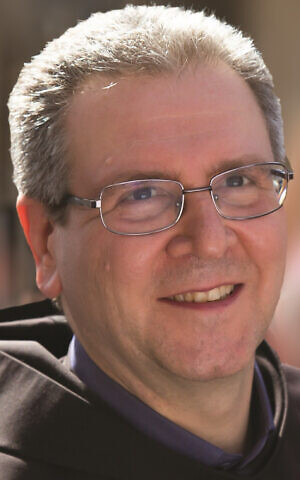
Fr. Francesco Patton, Custos of the Holy Land, Guardian of the Christian Holy Places in the Holy Land on behalf of the Catholic Church (Courtesy)
He cited seven incidents that have taken place in recent weeks, saying pointedly that “it is no coincidence that these serious incidents are taking place specifically now.”
“We expect and demand from the Israeli government and law enforcement to act with determination to stamp these serious phenomena.”
While there have long been periodic incidents of vandalism and harassment against Christian clergy in Jerusalem’s Old City, there has been a noticeable rise in attacks in recent weeks.
In November, two soldiers from the Israel Defense Forces’ Givati Brigade were detained on suspicion of spitting at the Armenian archbishop and other pilgrims during a procession in the Old City.
In early January, two Jewish teens were arrested for damaging graves at the Protestant cemetery on Mount Zion.
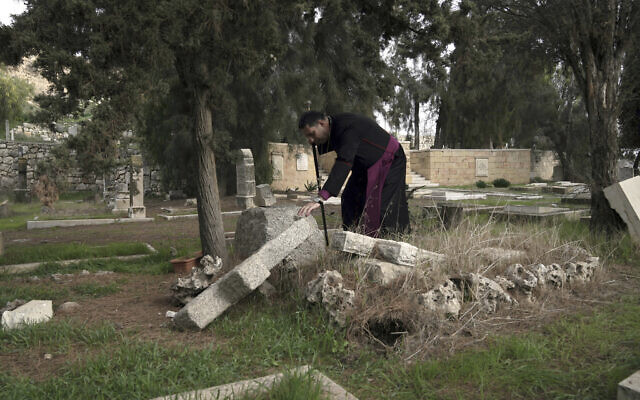
Hosam Naoum, a Palestinian Anglican bishop, touches a damaged grave where vandals desecrated dozens of graves at the historic Protestant Cemetery on Jerusalem’s Mount Zion in Jerusalem, January 4, 2023. (Mahmoud Illean/AP)
The next week, the Maronite community center in the northern city of Ma’alot-Tarshiha was vandalized by unknown assailants over the Christmas holiday.
Jerusalem’s Armenian community buildings were also targeted by vandals, with multiple discriminatory phrases graffitied on the exterior of structures in the Armenian Quarter. According to the Armenian Patriarchate, “revenge,” “death to Christians,” “death to Arabs and gentiles” and “death to Armenians” were all graffitied in the quarter.
The attacks kept coming. On a Thursday night in late January, a gang of religious Jewish teens threw chairs at an Armenian restaurant inside the city’s New Gate. The vandalism at the Church of the Flagellation occurred the very next week.
And last week, a resident of southern Israel was arrested after attacking priests with an iron bar at the Tomb of the Virgin Mary in Gethsemane.
“Terrorist attacks, by radical Israeli groups, targeting churches, cemeteries, and Christian properties… have become almost a daily occurrence that evidently increases in intensity during Christian holidays,” said the Greek Orthodox Church.
“If you are a Christian in the Middle East, there’s only one place where you are safe,” asserted Prime Minister Benjamin Netanyahu, speaking to Christian Zionists in Rio de Janeiro in December 2018. “There’s only one place where the Christian community is growing, thriving, prospering. That’s in the State of Israel.”
Netanyahu’s claim is a central element of the image Israeli officials put forward about the country when speaking to Western audiences.
Ahead of Christmas last year, Israel’s official Twitter account posted a video of the Foreign Ministry’s Digital Diplomacy chief David Saranga on a “magical Christmas stroll” through Jerusalem’s Old City.
State of Jerusalem: The ‘Secular’ StrugglePauseUnmute
Loaded: 21.51%Picture-in-PictureFullscreenClose
The picture of safe coexistence painted by Israeli officials is starkly at odds with the experiences Jerusalem’s Christian leaders themselves describe. While they readily acknowledge that there is no organized or governmental effort against them, Christian clergy in the Old City tell of a deteriorating atmosphere of harassment, apathy from authorities, and a growing fear that incidents of spitting and vandalism could turn into something far darker.
And with Netanyahu already under scrutiny from Western allies over policies toward the Palestinians and attempts at sweeping judicial reform, deteriorating safety for Christians — or at least Church leaders disseminating that narrative — could become another serious diplomatic problem for Israel’s embattled government.
Get The Times of Israel’s Daily Editionby email and never miss our top storiesNewsletter email addressGET IT
By signing up, you agree to the terms
March of the schoolchildren
On Friday, hundreds of Catholic schoolchildren in Jerusalem embarked on their traditional march along the Via Dolorosa as they do every year during the 40 days of Lent.

Catholic schoolchildren walk down the Via Dolorosa, March 24, 2023 (Filippo De Grazia)
This time was different, however.
The students set off from the Church of the Flagellation, the second station of the cross, all clad in identical red scarves that bore the image of a broken statue of Jesus, the Scourged Savior effigy vandalized by an American Jewish tourist in the church in February.
ADVERTISEMENT
The march, joined by the two senior Catholic figures in the Holy Land — Patriarch Pierbattista Pizzaballa and Custodian of the Holy Land Francesco Patton — was not limited to a protest against that one incident.
“We are horrified and hurt in the wake of the many incidents of violence and hatred that have taken place recently against the Catholic community in Israel,” said Patton, also known as the Custos.

Fr. Francesco Patton, Custos of the Holy Land, Guardian of the Christian Holy Places in the Holy Land on behalf of the Catholic Church (Courtesy)
He cited seven incidents that have taken place in recent weeks, saying pointedly that “it is no coincidence that these serious incidents are taking place specifically now.”
“We expect and demand from the Israeli government and law enforcement to act with determination to stamp these serious phenomena.”
While there have long been periodic incidents of vandalism and harassment against Christian clergy in Jerusalem’s Old City, there has been a noticeable rise in attacks in recent weeks.
In November, two soldiers from the Israel Defense Forces’ Givati Brigade were detained on suspicion of spitting at the Armenian archbishop and other pilgrims during a procession in the Old City.
In early January, two Jewish teens were arrested for damaging graves at the Protestant cemetery on Mount Zion.

Hosam Naoum, a Palestinian Anglican bishop, touches a damaged grave where vandals desecrated dozens of graves at the historic Protestant Cemetery on Jerusalem’s Mount Zion in Jerusalem, January 4, 2023. (Mahmoud Illean/AP)
The next week, the Maronite community center in the northern city of Ma’alot-Tarshiha was vandalized by unknown assailants over the Christmas holiday.
Jerusalem’s Armenian community buildings were also targeted by vandals, with multiple discriminatory phrases graffitied on the exterior of structures in the Armenian Quarter. According to the Armenian Patriarchate, “revenge,” “death to Christians,” “death to Arabs and gentiles” and “death to Armenians” were all graffitied in the quarter.
The attacks kept coming. On a Thursday night in late January, a gang of religious Jewish teens threw chairs at an Armenian restaurant inside the city’s New Gate. The vandalism at the Church of the Flagellation occurred the very next week.
https://platform.twitter.com/embed/Tweet.html?dnt=true&embedId=twitter-widget-0&features=eyJ0ZndfdGltZWxpbmVfbGlzdCI6eyJidWNrZXQiOltdLCJ2ZXJzaW9uIjpudWxsfSwidGZ3X2ZvbGxvd2VyX2NvdW50X3N1bnNldCI6eyJidWNrZXQiOnRydWUsInZlcnNpb24iOm51bGx9LCJ0ZndfdHdlZXRfZWRpdF9iYWNrZW5kIjp7ImJ1Y2tldCI6Im9uIiwidmVyc2lvbiI6bnVsbH0sInRmd19yZWZzcmNfc2Vzc2lvbiI6eyJidWNrZXQiOiJvbiIsInZlcnNpb24iOm51bGx9LCJ0ZndfbWl4ZWRfbWVkaWFfMTU4OTciOnsiYnVja2V0IjoidHJlYXRtZW50IiwidmVyc2lvbiI6bnVsbH0sInRmd19leHBlcmltZW50c19jb29raWVfZXhwaXJhdGlvbiI6eyJidWNrZXQiOjEyMDk2MDAsInZlcnNpb24iOm51bGx9LCJ0ZndfZHVwbGljYXRlX3NjcmliZXNfdG9fc2V0dGluZ3MiOnsiYnVja2V0Ijoib24iLCJ2ZXJzaW9uIjpudWxsfSwidGZ3X3ZpZGVvX2hsc19keW5hbWljX21hbmlmZXN0c18xNTA4MiI6eyJidWNrZXQiOiJ0cnVlX2JpdHJhdGUiLCJ2ZXJzaW9uIjpudWxsfSwidGZ3X2xlZ2FjeV90aW1lbGluZV9zdW5zZXQiOnsiYnVja2V0Ijp0cnVlLCJ2ZXJzaW9uIjpudWxsfSwidGZ3X3R3ZWV0X2VkaXRfZnJvbnRlbmQiOnsiYnVja2V0Ijoib24iLCJ2ZXJzaW9uIjpudWxsfX0%3D&frame=false&hideCard=false&hideThread=false&id=1618984343829098498&lang=en&origin=https%3A%2F%2Fwww.timesofisrael.com%2Fas-attacks-on-christians-become-more-frequent-a-crisis-looms-for-israel%2F&sessionId=00fd415bf55462209a994fd9ef678499cd519944&siteScreenName=timesofisrael&theme=light&widgetsVersion=aaf4084522e3a%3A1674595607486&width=550px
And last week, a resident of southern Israel was arrested after attacking priests with an iron bar at the Tomb of the Virgin Mary in Gethsemane.
“Terrorist attacks, by radical Israeli groups, targeting churches, cemeteries, and Christian properties… have become almost a daily occurrence that evidently increases in intensity during Christian holidays,” said the Greek Orthodox Church.
ADVERTISEMENT
And not all incidents even make the news. Father Matthew, secretary to the Greek Orthodox Patriarch Theophilus III, told The Times of Israel that last Tuesday, a handicapped priest making his way slowly out of the Greek Orthodox monastery was spat on by two religious Jewish youths. When another priest confronted the assailants, they pulled up their shirts to show canisters of pepper spray.
According to Father Matthew, the police detained, then released, the attackers.
Jerusalem Police told The Times of Israel it was not familiar with the incident, and asked for additional details.
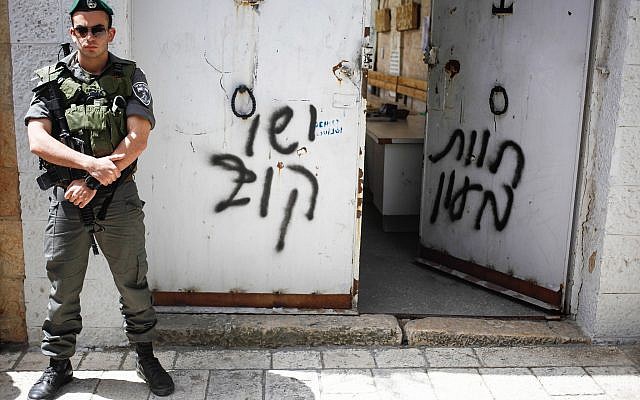
A Border Police guard stands next to anti-Christian graffiti reading in Hebrew, “Jesus is a monkey” on the Church of the Dormition, in Jerusalem on May 31, 2013. (Flash90)
Church officials are critical of the overall police response.
“The police try to paint each attack as something isolated, and try to paint the attackers as mentally unstable,” said Amir Dan, spokesman for the Franciscan Custody of the Holy Land. “In doing so, the police remove themselves from all responsibility.”
Indeed, after the Church of the Flagellation attack, police said they were checking whether the suspect had mental health issues. Police told The Times of Israel that the attacker at Mary’s Tomb — a Christian Moldovan-Israeli — was committed to a mental hospital temporarily.
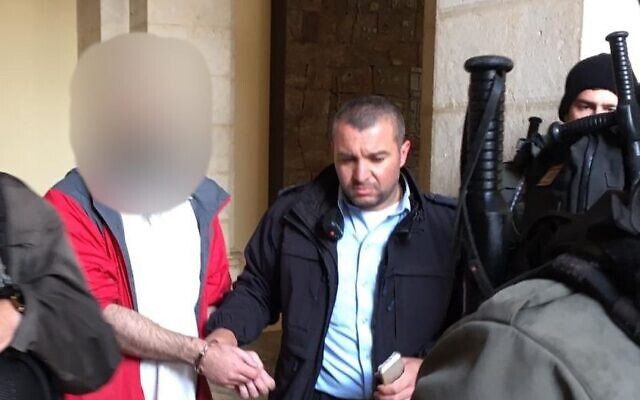
A US tourist, left, is led away by police on suspicion that he vandalized a statue in the Church of the Flagellation in the Old City of Jerusalem, February 2, 2023. (Israel Police)
The Franciscans in the Old City are so worried that they have been locking the doors to their San Salvatore compound in the Old City at night ever since the desecration of the Jesus statue. They have never taken such a measure in the past, said Father Alberto Pari, secretary of the Custody.
Source: Timesofisrael


